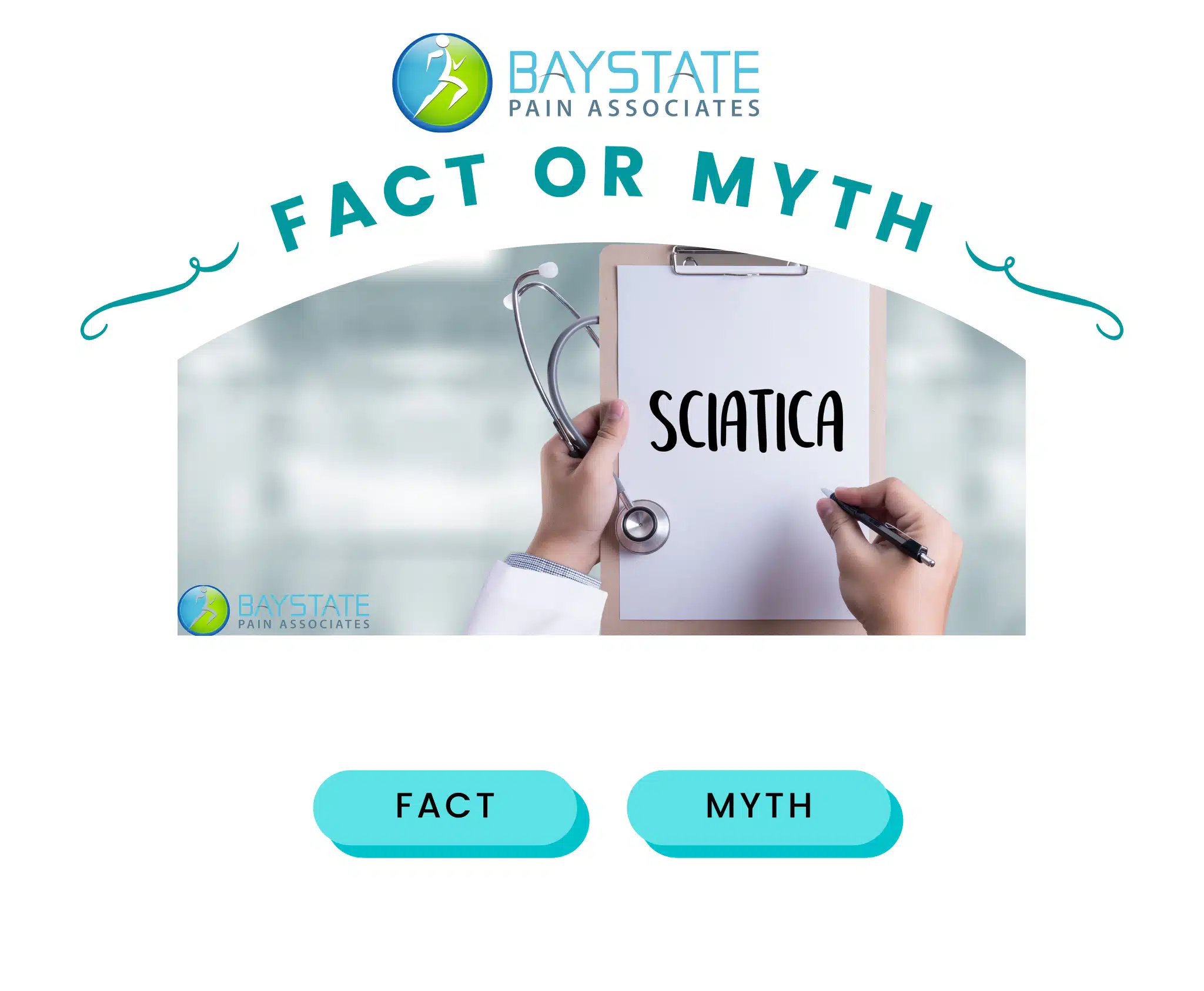 There are many myths about sciatica. I would like to dispel some of the most common sciatica myths so that you can make informed decisions about your condition.
There are many myths about sciatica. I would like to dispel some of the most common sciatica myths so that you can make informed decisions about your condition.
Myth 1: Sciatica Is a Condition or a Diagnosis
Fact: People commonly call sciatica a condition or a diagnosis, but it is really a symptom, indicating that something is irritating a nerve root in the lower back.
The important thing is to decipher what is causing the pressure on the nerve.
Myth 2: All Leg Pain Qualifies as Sciatica
Fact: people who believe that any leg pain qualifies as sciatica, but that’s not true.
Leg pain can be induced by vascular issues, muscle strains, cellulitis, or a different nerve being irritated, such as the femoral nerve, which would cause pain in the front of the leg.
A true sciatic symptom runs from the mid-buttock down the back of the leg, commonly past the knee and down through the calf.
Myth 3: We Don’t Know What Causes Sciatica
Fact: Sciatica occurs when the sciatic nerve becomes pinched or compressed, and that typically is caused by a bulging or herniated disk between the vertebrae in the lower spine.
It can also be caused by a bone spur, or bony growth, on the spine itself or by spinal stenosis, a narrowing of the spinal canal. In rare cases, a spinal tumor can compress the nerve, causing sciatic pain.
Myth 4: A Specific Event Brings on Sciatica
Fact: People often think if they didn’t lift that suitcase, sit on a long flight, or help a friend move they would not have pain
Most of the time, the intervertebral disk has a small defect and is ready to herniate, and [the sciatica is] not necessarily caused from that specific event, certain jobs may lead to sciatica.
Myth 5: If You Have Sciatica, You Should Stay in Bed and Rest
Fact: “Most patients do better if they remain active and avoid excessive rest,”
Numerous studies have found that there is little to no benefit to staying in bed compared with staying active for people with sciatica.
Myth 6: Medication Is the Best Way to Provide Relief From Sciatica
Fact: You might think that taking an analgesic or anti-inflammatory drug could ease the pain of sciatica, but in fact, found a lack of evidence of the efficacy of drugs including NSAIDs, corticosteroids, antidepressants, and opioid analgesics.
But short-term treatment with an anti-inflammatory or acetaminophen can be helpful for some people.
Epidural steroid injections are typically indicated for acute radiculopathy [pinched nerve root]. They do not typically help for chronic sciatica.”
Myth 7: Surgery Is the Only Way to Truly Remedy Sciatica
Fact : Most cases of sciatica resolve within about six weeks and do not need surgery, Other treatments, including physical therapy and epidural injections, can be useful. But “if these treatments fail, or, in rare cases, where there is severe weakness, numbness, or pain, surgery can substantially and durably improve sciatic pain
Myth 8: Sometimes Nothing Helps Sciatica
Myth 9: Sciatica Cannot Be Prevented
Fact: Not all cases of sciatica can be prevented, but staying active — and using proper form during activities — can go a long way toward reducing the incidence and recurrence of lower back pain, according to Fishman.
Spinner adds that maintaining a strong core — that is, strengthening the muscles in your abdomen and back — can also help prevent sciatica recurrence.
Sciatica can be prevented by practicing good posture, minimizing sitting, managing weight, maintaining good hamstring flexibility, and maintaining good spinal alignment.
Pilates is notable for increasing core strength and can be adapted to many health conditions, including sciatica.
Myth 10: Sciatica will only get worse with exercise.
Fact : You may be tempted to stay away from physical activity if you’re facing sciatica. Since inactivity for a long period of time can lead to weak back muscles that exacerbate the pain, it’s important to exercise and engage in stretching exercises such as yoga on a regular basis.
If you have sciatica and are ready to find relief, don’t hesitate to visit your doctor as soon as possible. Conservative treatments may be just what you need to get your life back.
Myth 11: Sciatica can not cause permanent nerve damage.
Fact : Sciatica can potentially cause permanent nerve damage, resulting in a loss of feeling in the affected legs. If you notice a loss in leg sensation or bowel or bladder incontinence, you may be at risk for this type of damage. Call your provider right away if you lose feeling in your legs or feet, or have any concerns during your recovery time.
Myth 12: Sciatica will go away on its own some rest.
Fact : Many people assume that they don’t have to do much to find relief from sciatica pain. While rest may help, other treatments such as medications like muscle relaxants and anti-inflammatories, steroid injections, and physical therapy are likely necessary. Fortunately, surgery is only reserved for the most severe cases.
What are the causes of sciatica?
- Age. Age-related changes in the spine, such as herniated disks and bone spurs, are the most common causes of sciatica.
- Obesity. By increasing the stress on your spine, excess body weight can contribute to the spinal changes that trigger sciatica.
- Occupation. …
- Prolonged sitting. …
- Diabetes.
Editorial Sources and Fact-Checking
References
- Euro U, Knekt P, Rissanen H, et al. Risk Factors for Sciatica Leading to Hospitalization. European Spine Journal. June 13, 2017.
- Hagen KB, Hilde G, et al. Bed Rest for Acute Low Back Pain and Sciatica. The Cochrane Database of Systematic Reviews. October 2004.
- Pinto RZ, Maher CG, Ferreira ML, et al. Drugs for Relief of Pain in Patients With Sciatica: Systematic Review and
- Meta-analysis. BMJ. February 2012.
Sources
- Sciatica — Overview. Mayo Clinic. August 14, 2015.



